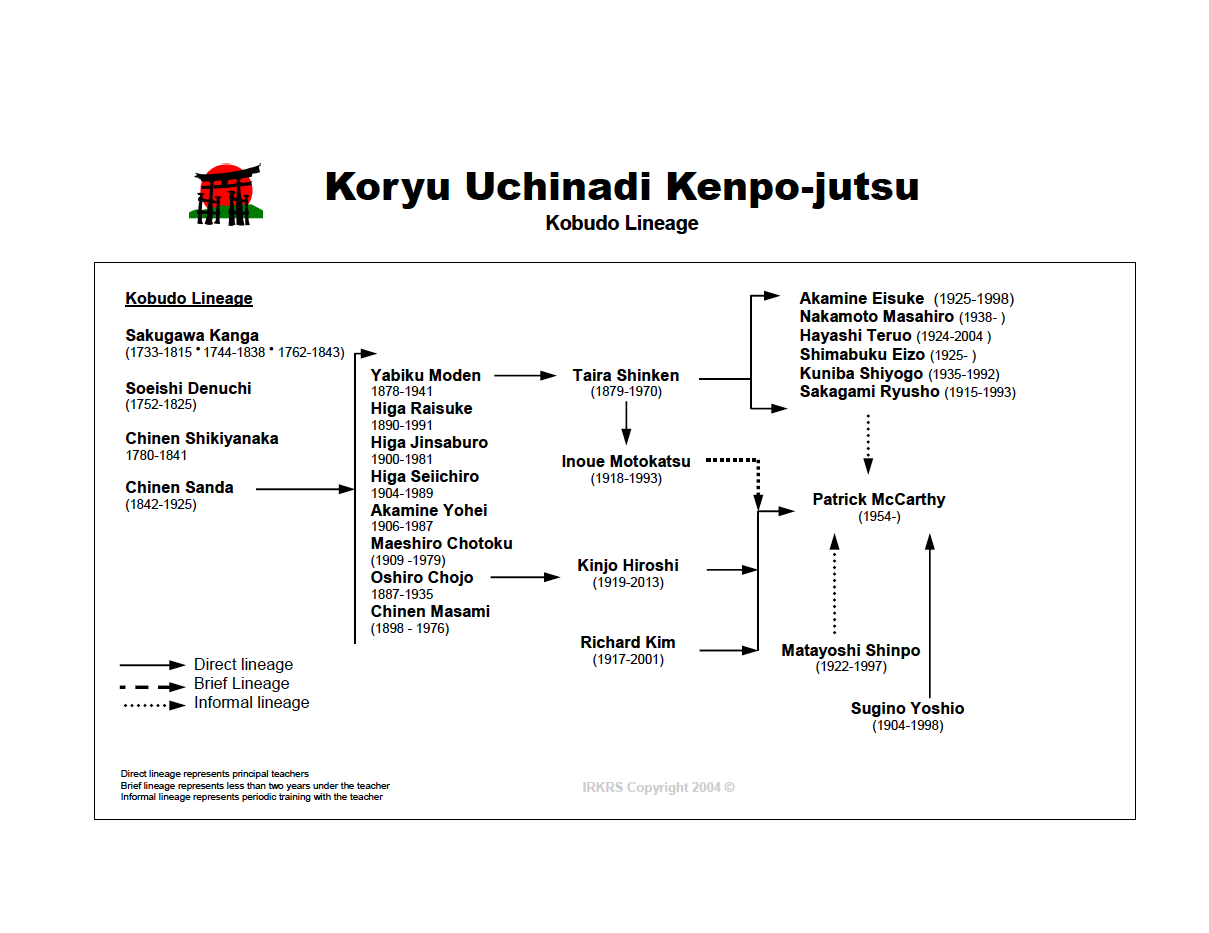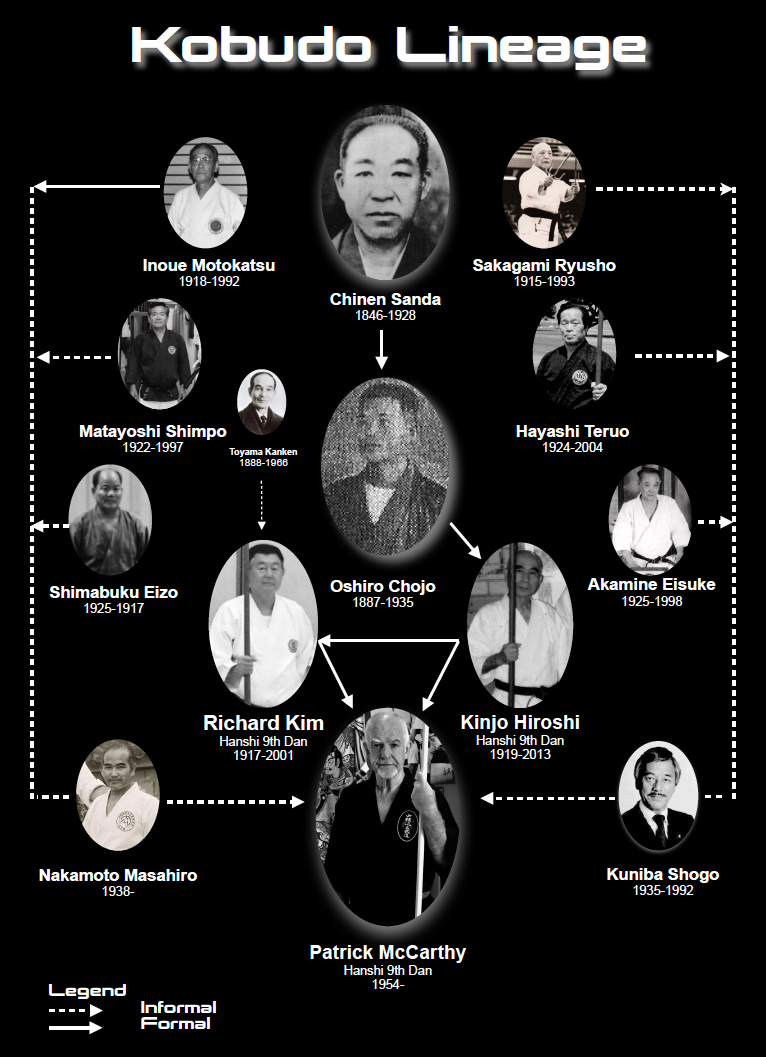There are several methods of Okinawan Kobudo widely practiced throughout the modern Karate world today. Amidst the most popular of these modern traditions are the Yabiku-Taira and Matayoshi methods. The third method of Kobudo known as Yamane-ryu [aka Yamanni Ryu]. Until recent times, Yamane-ryu has remained virtually unknown in the karate world outside of Okinawa.
While an entire dissertation might better illuminate the obscurity surrounding this phenomenon, a simple explanation tells us that such differences came about largely due to Kobudo unfolding alongside modern karate. In the same way that old-school Okinawan karate conformed to the powerful forces of Japanese-ness, so too was modern Kobudo similarly influenced. Introduced to the mainland of pre-war Japan during an era of radical military escalation, the original practice & purpose of Karate & Kobudo took on characteristics uniquely Japanese and have, for the most part, remained that way.
While the actual evolution of bojutsu remains the subject of intense curiosity we do know that the origins of the Yamane Ryu can be traced back through Chinen Pechin (c. 1846-1928). From the village of Samukawa in the old castle district of Shuri, Chinen Sanda was born the son of a Pechin class Kemochi during the later part of Okinawa’s old Ryukyu Kingdom. Also known Chinen Pechin, or Yamane no Chinen [as Taira Shinken described him in his 1964 Encyclopedia of Kobudo], the youth was schooled in Uchinadi by his uncle, Chinen Sanjin Andaya Pechin (1797-1881,) also known as Aburaiya Yamagusuku.
In spite of his proficiency with several kinds of bojutsu, Chinen most favored the traditions of Sakugawa and Shikiyanaka, but is probably best remembered for being a brilliant innovator. In an effort to help facilitate the teaching of fundamental technique, Chinen ingeniously developed three unique exercises that he called Shuji, Yonekawa and Shirotaru. He passed away at the ripe old age of 82 leaving behind him a rich & unique legacy.
Among Chinen’s most prominent students were Yabiku Moden, Higa Raisuke, Higa Seiichiro, Higa Ginsaburo, Akamine Yohei, Maeshiro Chotoku, his own grandson Masami and his most prominent disciple Oshiro (Ogusuku) Chojo; McCarthy Sensei’s teacher, Kinjo Hiroshi, was a direct student under Chinen Sanda, Oshiro Chojo and Maeshiro Chotoku.
Given the name Yamane-ryu by Chinen Masami (1898-1976,) the grandson of Chinen Sanda, the term actually brings together three separate Chinese ideograms: 1. “Yama,” meaning “mountain;” 2. “Ne,” meaning “foundation or root;” and 3. ” Ryu,” meaning, “stream.” The term was simply intended to describe the locale in Shuri’s Samukawa village from whence Chinen’s tradition came.
Despite the widespread attention Yabiku Moden attracted (largely because of the popularity his student Taira Shinken) Oshiro Chojo (1887-1935) was the most visible proponent of Chinen Sanda during his day. Every year on 11 August, the people of Chinen Village used to gather to commemorate the life of Bushi Shikiyanaka [1780-1841.] 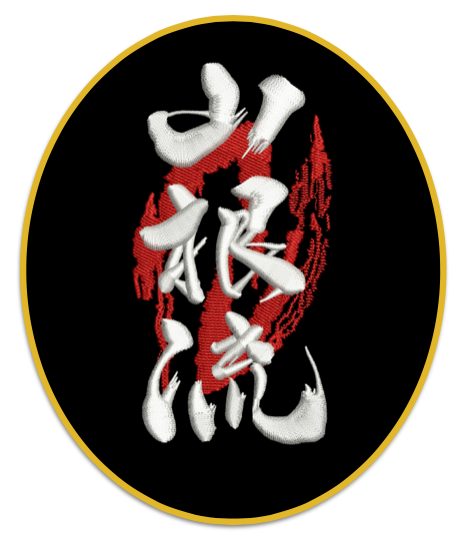
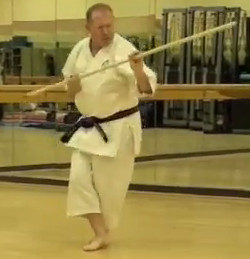
Sensei Darrin Johnson performing Koryu no Kon [aka, Oshiro Bo]
Bushi Shikiyanaka was a well known retainer of Governor Soeishi who had made a notable reputation for himself as a virtuous man with remarkable fighting skills in Soeishi family-style bojutsu. The legacy of this expert was handed down through a series of ritualized (bo) exercises posthumously named Chinen Shikiyanaka no kon. One jikideshi (direct student) of Chinen Sanda who gained widespread notoriety for the way in which he performed these exercises was Oshiro Chojo. In fact, so skillful was Oshiro in the techniques of Bushi Shikiyanaka that the people of Chinen village always petitioned him to perform on August 11th in honor of the great Master. Oshiro is especially remembered for his performance of the Shikiyanaka bo style before the Emperor’s family in 1924. Like many Uchinadi teachers before him, so too did Master Oshiro teach his art through ritualized sequences and associated drills that linked fundamental technique to corresponding defensive themes.
![Working Pechin Kumi-bo practice, at learning speed, with my German student, Dirk Thesenvitz [Berlin] in Brisbane at the old ACNM college dojo. The practice is a personal derivation of an earlier kumi-bo exercise developed by Inoue Motokatsu, under whom I learned directly during the late 1980's at the Shibuya dojo in Tokyo.](https://www.koryu-uchinadi.com/new_IRKRS_defaultpage/wp-content/uploads/2013/03/Pechin-Kumi-bo-300x228.png)
Working Pechin Kumi-bo practice, at learning speed, with my German student, Dirk Thesenvitz [Berlin] in Brisbane at the old ACNM college dojo. The practice is a personal derivation of an earlier kumi-bo exercise developed by Inoue Motokatsu, under whom McCarthy Hanshi learned directly during the late 1980’s at the Shibuya dojo in Tokyo.
Identified by its signature characteristics, Yamane-ryu bojutsu employs swift but powerful circular motion, a distinct pattern of twisting thrusts, vibrant body dynamics and pliable footwork. Some are of the opinion that the method is closely connected to So-jutsu, the art of spearman-ship. However, its pliable manner is consistent with the old-school Chinese-based Uchinadi once practiced during Okinawa’s old Ryukyu Kingdom. Classically speaking, Yamane-ryu refers to five kata; Shuji, Sakugawa, Chinen Shikiyanaka, Shirotaru and Yonekawa. Recently, however, highly motivated Kobudo enthusiasts are beginning to apply the principles of Yamane-ryu to their own Kobudo traditions in an effort to improve its pliability and enhance its overall effectiveness.
A Personal Journey
Patrick McCarthy’s personal Kobudo journey had been inspired by the teachings of his esteemed Okinawan instructor, Kinjo Hiroshi [金城 裕, 1919-2013], and key figures under whom he studied; Chinen Sandā [知念三良, 1842–1925], Ōshiro Chōjo [大城朝怒, 1887-1935], and Maeshiro Chōtoku [真栄城朝亮, 1909-1979]. Amidst other pioneers, these people were pivotal figures before the style gained official recognition as “Yamane Ryu/山根流棒術” by Chinen’s grandson, Masami [知念正実, 1898–1976].
Chinen-ha Yamamni Ryu
Although McCarthy Sensei had met and practiced, back in the mid 1980s, with both Prof. Shinzato Katsuhiko and Kishaba sensei, along with being influenced by a pantheon of other wonderfully skillful instructors, including the very popular Oshiro Toshihiro and Nishime Kiyoshi [both of whom were largely responsible for first popularizing the little known practice outside of Okinawa], he has no connection to, nor purport to be associated with, in any way, the Chinen Masami Yamane Ryu Bojutsu lineage. McCarthy’s Yamane Ryu Kobudo practice, extends beyond just bojutsu [棒術] and into an entire range of traditional weapons, not originally known within Masami’s practice; i.e. Eku, Nicho-gama, Nunchaku, Sai, Suruchin, Tanbo, Tanto, Tekko/Techu, Tinbe and Tonfa-jutsu, etc.
The practical, technical and pedagogical approach to learning, practice and teaching McCarthy Sensei established stemmed from; #1. A strong foundation in Okinawan Kobudo gained under the tutelage of Grandmaster Richard Kim [1917-2001, Zen Bei Butokukai] and #2. Years of historical study and cross-training opportunities in related arts, and often with the most senior authorities of various Kobudo traditions; i.e. Having studied directly under Richard Kim [1917-2001], Inoue Motokatsu [1918-1992] and Kinjo Hiroshi [1919-2013], McCarthy’s study was further influenced by lengthy research, extensive cross-training, and his informal association with a pantheon of other notable instructors; i.e. Sakagami Ryusho [1915-1993], Matayoshi Shinpo [1922-1997], Akamine Eisuke [1925-1998], Kuniba Shogo [1935-1992], Shimabuku Eizo [1925-2017], Hayashi Teruo [1924-2004], Nakamoto Masahiro [1938] and Inoue Motokatsu [1918-1993], et al.
Iemoto (家元)
Contrary to the misleading article targeting our Yamane Ryu practice, the iemoto system was established by the Japanese and has long served as a method for preserving Koryu-based Japanese arts through recognized authorities known as sōke or Iemoto. Such individuals inherit and pass down preserved (unchanged) knowledge through generations, upholding family-based practices and guiding students in various arts such as tea ceremonies, flower arrangements, chess, and martial arts. It’s important to note that such a system was not historically used during the Ryukyu Kingdom nor as an Okinawan practice. Until the time of Yabiku Mōden (屋比久 孟伝, 1878-1941), and Taira Shinken (平 信賢, 1897–1970), Kobudo as we know it today was never a systematized tradition nor based upon the iemoto system.
The mention about only those with licensed authorization from Iemoto (家元, i.e. authorized disciples], has no bearing upon contemporary -based and/or integrated practices; However, when outsiders [i.e. Westerners] innovate and/or reinterpret existing and/or classical practices, it’s not surprising that style-based gatekeepers perceive it as a threat and/or appallingly disrespectful, and/or, “worthless!” While we certainly respect such opinions, we obviously do not support such thinking and have been totally transparent about how and what we teach and where it comes from.
Sogo Budo (総合武道) ~ Gendai Budo (現代武道)
Sogo Budo (総合武道) is a term which refers to integrated or comprehensive fighting art[s]. While carrying a similar meaning, Gendai Budo (現代武道) is a term which refers to modern or contemporary fighting art[s]. By collectively bringing together his many years of experience to establish an integrated and contemporary practice, which better suited McCarthy Sensei’s personal preferences, the practice was intended to pay homage to his instructor[s], under whom he was empowered, along with paying homage to both the tradition and culture from which it comes.
Oshiro-ha Yamane-ryu Kobudo/大城派山根流古武道]
By definition, the contemporary interpretation of classical tradition, described as Oshiro-ha Yamane-ryu Kobudo [大城派山根流古武道], can be described as either Sogo Budo (総合武道) or Gendai Budo (現代武道).
The principal source, under which McCarthy Sensei’s Okinawan instructor [Kinjo Hiroshi] studied, was Oshiro Chojo/大城朝恕 [1887-1935]. In addition to his passion for Karate, Oshiro is best remembered for his incredible skill with the Rokushaku bo/六尺棒. Deeply inspired by Oshiro’s far-reaching legacy, and with the blessings of Kinjo Sensei, the name Oshiro-ha Yamane-ryu Kobudo, examples McCarthy Sensei’s sincere desire to pay tribute and homage to this wonderfully unique lineage.
Excerpts from forthcoming Yamane Ryu book…
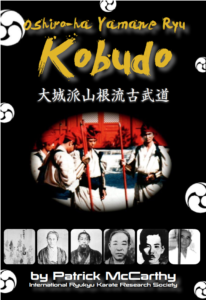 “Once an obscure and little-known tradition, Yamane-ryu has grown into an international phenomenon thanks largely to its uniqueness and public acceptance. Characterised by its fluid motion, unique footwork and hip rotation, and dynamic power, the tradition stands alone as a hallmark in the annals of kobudo history. Evolving from the teachings of Chinen Sanda, who fostered many disciples, his valuable lessons have been handed down by only a select few and this vanguard publication clearly illuminates the shrouded passage through which it has journeyed. Yamane-ryu was first popularized in the west by the talented students of Kishaba Chogi, who had learned bojutsu from Chinen Masami, the grandson of Chinen Sanda. Yet, in spite of this, its immense popularity has also given rise to rumors surrounding its lineage and legacy. This situation demands nothing short of a definitive explanation of the tradition and its many lineages.
“Once an obscure and little-known tradition, Yamane-ryu has grown into an international phenomenon thanks largely to its uniqueness and public acceptance. Characterised by its fluid motion, unique footwork and hip rotation, and dynamic power, the tradition stands alone as a hallmark in the annals of kobudo history. Evolving from the teachings of Chinen Sanda, who fostered many disciples, his valuable lessons have been handed down by only a select few and this vanguard publication clearly illuminates the shrouded passage through which it has journeyed. Yamane-ryu was first popularized in the west by the talented students of Kishaba Chogi, who had learned bojutsu from Chinen Masami, the grandson of Chinen Sanda. Yet, in spite of this, its immense popularity has also given rise to rumors surrounding its lineage and legacy. This situation demands nothing short of a definitive explanation of the tradition and its many lineages.
This book does that and much more. In addition, the recent popularity of Yamane-ryu has also spurred many to explore the alternative sources from which the tradition has been handed down to our times. One such lineage is that of Oshiro Chojo, arguably the most visible students of Chinen Sanda. In fact, it was Oshiro’s bojutsu that was included in Miki Jisaburo’s 1930 classic, Kenpo Gaisetsu, which contained the first ever published technical record of Ryukyu Kobudo featuring the traditions of Shuji, Sakugawa and Shirotaru. Indeed, it is also the bojutsu of Oshiro Chojo that forms the basis for the Yamane-ryu found within these pages. It can be said that the Yamane-ryu tradition continues to grow and evolve, as practitioners find that they can adapt the principles, body dynamics and flow of Yamane-ryu technique to any bojutsu kata, and to any of the other Ryukyu Kobudo weapons, too.
Perhaps it may even be more correct to say that Yamane-ryu is compelling all Ryukyu Kobudo to go back to its roots, from a rigid tradition heavily influenced by modern karate to one that is reclaiming its fluidity and powerful application practices. Quoting McCarthy Hanshi, “I am absolutely certain that this is far more in line with the spirit and aims of the original pioneers then it is with today’s overblown emphasis placed upon incongruous practices and the conceit associated with one’s “style” being the ONE & ONLY CORRECT WAY!” In either case Yamane-ryu, a tradition once in fear of vanishing all together, has resurfaced and is here to stay. This publication is a journey into this tradition.“
Joe Swift
Tokyo, Japan
“My teacher, Oshiro Chojo (1887-1935) was a senior student of Yamaneryu Kobudo founder Chinen Sanda (1842-1925). On October 12, 1934, I participated in a demonstration before Prince Fushinomiya Hiroyasu (1875-1946), at which Oshiro Chojo was the guest speaker. I believe that was one of the highlights of my teacher’s, and my own, karate career. On that, I believe that this publication is also a fitting tribute to my teacher and I am grateful to Mr. McCarthy for undertaking this project. Although it may seem easy for a Japanese person to correctly understand the Japanese culture, it is actually very difficult. It is even harder for the Japanese to fully understand a foreign culture. In the same way, there are also difficulties in trying to get a non-Japanese person to understand the intricacies of the Japanese culture. I pray from the bottom of my heart that Yamaneryu Kobudo will be read far and wide, throughout the world.“
Kinjo Hiroshi
Hiratsuka, Japan
“It is with great enthusiasm that I write this for the publication Yamane-ryu Kobudo, by my friend and world-renowned karate researcher, Patrick McCarthy. I know of no foreign martial artist who loves Ryukyu as much as Mr. McCarthy, nor of any enthusiast who has researched the Ryukyuan martial arts to the depth that he has. His understanding of Ryukyu karate is beyond comparison. He is also someone who I have no reservations in calling one of the premier researchers of Ryukyu karate today. He travels the world, spreading the true essence of Ryukyu karate and kobujutsu to all who will listen. In fact, this is his life’s work, and his contributions to the art are innumerable. I have not met a foreign enthusiast who takes more pride in Ryukyu karate than Mr. McCarthy does. I believe that every reader will be able to immediately recognize the importance of this book. It truly is a publication that looks toward Okinawan culture to discover the spirit and the originality of the martial arts that lie hidden within.”
Hokama Tetsuhiro
Okinawa, Japan
——————–

![1994 Shuri Castle – Okinawa: Patrick McCarthy [9th Dan Hanshi] is the most senior ranked student of Grandmaster, Kinjo Hiroshi [DOB 1919-2013]](https://www.koryu-uchinadi.com/new_IRKRS_defaultpage/wp-content/uploads/2013/03/IRKRS-Yamane-Ryu-Kobudo.png)
